Astrid Lindgren
Astrid Anna Emilia Lindgren (Swedish: [ˈǎsːtrɪd ˈlɪ̌ŋːɡreːn] (![]() listen); née Ericsson; 14 November 1907 – 28 January 2002) was a Swedish writer of fiction and screenplays.[3] She is best known for several children's book series, featuring Pippi Longstocking, Emil i Lönneberga, Karlsson-on-the-Roof, and the Six Bullerby Children (Children of Noisy Village in the US), and for the children's fantasy novels Mio, My Son, Ronia the Robber's Daughter, and The Brothers Lionheart. Lindgren worked on the Children's Literature Editorial Board at the Rabén & Sjögren publishing house in Stockholm and wrote more than 30 books for children.[4] In January 2017, she was calculated to be the world's 18th most translated author,[5] and the fourth most translated children's writer after Enid Blyton, Hans Christian Andersen and the Brothers Grimm. Lindgren has so far sold roughly 165 million books worldwide.[6] In 1994, she was awarded the Right Livelihood Award for "her unique authorship dedicated to the rights of children and respect for their individuality."
listen); née Ericsson; 14 November 1907 – 28 January 2002) was a Swedish writer of fiction and screenplays.[3] She is best known for several children's book series, featuring Pippi Longstocking, Emil i Lönneberga, Karlsson-on-the-Roof, and the Six Bullerby Children (Children of Noisy Village in the US), and for the children's fantasy novels Mio, My Son, Ronia the Robber's Daughter, and The Brothers Lionheart. Lindgren worked on the Children's Literature Editorial Board at the Rabén & Sjögren publishing house in Stockholm and wrote more than 30 books for children.[4] In January 2017, she was calculated to be the world's 18th most translated author,[5] and the fourth most translated children's writer after Enid Blyton, Hans Christian Andersen and the Brothers Grimm. Lindgren has so far sold roughly 165 million books worldwide.[6] In 1994, she was awarded the Right Livelihood Award for "her unique authorship dedicated to the rights of children and respect for their individuality."
Astrid Lindgren | |
|---|---|
.jpg.webp) Lindgren around 1960 | |
| Born | Astrid Anna Emilia Ericsson 14 November 1907 Vimmerby, Sweden |
| Died | 28 January 2002 (aged 94) Stockholm, Sweden[1][2] |
| Occupation | Writer |
| Language | Swedish |
| Nationality | Sweden |
| Period | 1944–1993 |
| Genre | Children's fiction, picture books, screenplays |
| Notable awards | Hans Christian Andersen Award for Writing 1958 Right Livelihood Award 1994 |
Biography
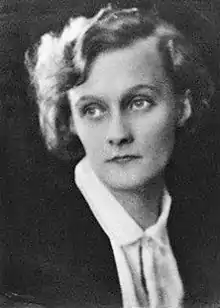
Astrid Lindgren grew up in Näs, near Vimmerby, Småland, Sweden, and many of her books are based on her family and childhood memories and landscapes.
Lindgren was the daughter of Samuel August Ericsson (1875–1969) and Hanna Jonsson (1879–1961). She had two sisters, Stina and Ingegerd, and a brother, Gunnar Ericsson, who eventually became a member of the Swedish parliament.
Upon finishing school, Lindgren took a job with a local newspaper in Vimmerby. She had a relationship with the chief editor, who was married who eventually proposed marriage in 1926 after she became pregnant. She declined and moved to the capital city of Stockholm, learning to become a typist and stenographer (she would later write most of her drafts in stenography). In due time, she gave birth to her son, Lars, in Copenhagen and left him in the care of a foster family.
Although poorly paid, she saved whatever she could and traveled as often as possible to Copenhagen to be with Lars, often just over a weekend, spending most of her time on the train back and forth. Eventually, she managed to bring Lars home, leaving him in the care of her parents until she could afford to raise him in Stockholm.
In 1932 she married her employer, Sture Lindgren (1898–1952), who left his wife for her. Three years later, in 1934, Lindgren gave birth to her second child, Karin, who would become a translator. The character Pippi Longstocking was invented to amuse her daughter while she was ill in bed. Lindgren later related that Karin had suddenly said to her, "Tell me a story about Pippi Longstocking," and the tale was created in response to that request.
The family moved in 1941 to an apartment on Dalagatan, with a view over Vasaparken, where Lindgren remained until her death on 28 January 2002 at the age of 94, having become blind.[7]
Astrid Lindgren died in her home in central Stockholm. Her funeral took place in the Storkyrkan (Great Church) in Gamla stan. Among those attending were King Carl XVI Gustaf with Queen Silvia and others of the royal family, and Prime Minister Göran Persson. The ceremony was described as "the closest you can get to a state funeral."[8]
Career
Lindgren worked as a journalist and secretary before becoming a full-time author.[9] She served as a secretary for the 1933 Swedish Summer Grand Prix. In the early 1940s, she worked as a secretary for criminalist Harry Söderman; this experience has been cited as an inspiration for her fictional detective Bill Bergson.[10]
In 1944 Lindgren won second prize in a competition held by Rabén & Sjögren, with the novel Britt-Marie lättar sitt hjärta (Britt-Marie Unburdens Her Heart).[11] A year later she won first prize in the same competition with the chapter book Pippi Långstrump (Pippi Longstocking),[12] which had been rejected by Bonniers. (Rabén & Sjögren published it with illustrations by Ingrid Vang Nyman, the latter's debut in Sweden.) Since then it has become one of the most beloved children's books in the world[13] and has been translated into 60 languages. While Lindgren almost immediately became a much appreciated writer, the irreverent attitude towards adult authority that is a distinguishing characteristic of many of her characters has occasionally drawn the ire of some conservatives.[14]
The women's magazine Damernas Värld sent Lindgren to the United States in 1948 to write short essays. Upon arrival she is said to have been upset by the discrimination against black Americans. A few years later she published the book Kati in America, a collection of short essays inspired by the trip.
In 1956, the inaugural year of the Deutscher Jugendliteraturpreis, the German-language edition of Mio, min Mio (Mio, My Son) won the Children's book award.[15][16] (Sixteen books written by Astrid Lindgren made the Children's Book and Picture Book longlist, 1956–1975, but only Mio, My Son won a prize in its category.)[17]
In 1958 Lindgren received the second Hans Christian Andersen Medal for Rasmus på luffen (Rasmus and the Vagabond), a 1956 novel developed from her screenplay and filmed in 1955. The biennial International Board on Books for Young People, now considered the highest lifetime recognition available to creators of children's books, soon came to be called the Little Nobel Prize. Prior to 1962 the Board cited a single book published during the preceding two years.[18][19]
On her 90th birthday, she was pronounced International Swede of the Year 1997 by Swedes in the World (SVIV – Svenskar i Världen), an association for Swedes living abroad.
In its entry on Scandinavian fantasy, The Encyclopedia of Fantasy named Lindgren the foremost Swedish contributor to modern children's fantasy.[20] Its entry on Lindgren was: "Her niche in children's fantasy remains both secure and exalted. Her stories and images can never be forgotten."[21]
Translations
By 2012 Astrid Lindgren's books had been translated into 95 different languages and language variants. Further, the first chapter of Ronja the Robber's Daughter has been translated into Latin. Up until 1997 a total of 3,000 editions of her books had been issued internationally,[22] and globally her books had sold a total of 165 million copies. Many of her books have been translated into English by the translator Joan Tate.
Politics

In 1976 a scandal arose in Sweden when it was publicised that Lindgren's marginal tax rate had risen to 102 percent. This was to be known as the "Pomperipossa effect", from a story she published in Expressen on 3 March 1976,[23] entitled Pomperipossa in Monismania, attacking the government and its taxation policies.[24] It was a satirical allegory in response to the marginal tax rate Lindgren had incurred in 1976,[25] which required self-employed individuals to pay both regular income tax and employers' deductions.[25] In a stormy tax debate, she attracted criticism from Social Democrats and even from her own colleagues, and responded by raising the issue of the lack of women involved in the Social Democrats' campaign.[26] In that year's general election, the Social Democratic government was voted out for the first time in 44 years, and the Lindgren tax debate was one of several controversies that may have contributed to the result. Another controversy involved Ingmar Bergman's farewell letter to Sweden, after charges had been made against him of tax evasion.[24] Lindgren nevertheless remained a Social Democrat for the rest of her life.[27]
In 1978, when she received the Peace Prize of the German Book Trade, Lindgren made a speech, Never Violence!. She spoke against corporal punishment of children. After that she teamed up with scientists, journalists and politicians to achieve non-violent upbringing. In 1979, a law was introduced in Sweden prohibiting violence against children.[28] Until then there was no such law anywhere in the world.[29]
From 1985 to 1989 Lindgren wrote articles concerning animal protection and mass production in the Swedish magazines Expressen and Dagens Nyheter along with the veterinarian Kristina Forslund. They wanted to launch an awareness campaign to promote better animal treatment in factory farming. Eventually their activities led to a new law which was called Lex Lindgren and was presented to Astrid Lindgren during her 80th birthday. During that time it was the strictest law concerning animal welfare in the world.[30] However, Lindgren and Forslund weren't satisfied with it. Not enough had been done and only minor changes occurred. The articles Forslund and Lindgren wrote were later published in the book Min ko vill ha roligt.[31]
Lindgren was well known both for her support for children's and animal rights and for her opposition to corporal punishment and the EU.[32] In 1994 she received the Right Livelihood Award, "For her commitment to justice, non-violence and understanding of minorities as well as her love and caring for nature."
Honors and memorials
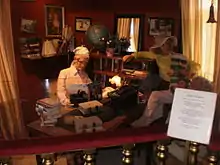
In 1967 the publisher Rabén & Sjögren established an annual literary prize, the Astrid Lindgren Prize, to mark her 60th birthday.[33] The prize—40,000 Swedish kronor—is awarded to a Swedish-language children's writer every year on Lindgren's birthday in November.[34]
Following Lindgren's death, the government of Sweden instituted the Astrid Lindgren Memorial Award in her memory. The award is the world's largest monetary award for children's and youth literature, in the amount of five million Swedish kronor.
The collection of Astrid Lindgren's original manuscripts in Kungliga Biblioteket in Stockholm (the Royal Library) was placed on UNESCO's Memory of the World Register in 2005.[35]
On 6 April 2011 Sweden's central bank Sveriges Riksbank announced that Lindgren's portrait will feature on the 20 kronor banknote, beginning in 2014–15.[36] In the run-up to the announcement of the persons who would feature on the new banknotes, Lindgren's name had been the one most often put forward in the public debate.
Asteroid Lindgren
Asteroid 3204 Lindgren, discovered in 1978 by Soviet astronomer Nikolai Chernykh, was named after her.[37] The name of the Swedish microsatellite Astrid 1, launched on 24 January 1995, was originally selected only as a common Swedish female name, but within a short time it was decided to name the instruments after characters in Astrid Lindgren's books: PIPPI (Prelude in Planetary Particle Imaging), EMIL (Electron Measurements – In-situ and Lightweight), and MIO (Miniature Imaging Optics).
Astrid's Wellspring
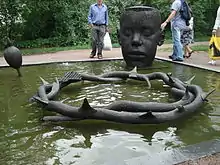
In memory of Astrid Lindgren, a memorial sculpture was created next to her childhood home, named Källa Astrid ("Astrid's Wellspring" in English). It is situated at the spot where Astrid Lindgren first heard fairy tales. The sculpture consists of an artistic representation of a young person's head (1.37 m high),[38] flattened on top, in the corner of a square pond, and, just above the water, a ring of rosehip thorn (with a single rosehip bud attached to it). The sculpture was initially slightly different in design and intended to be part of a fountain set in the city center, but the people of Vimmerby vehemently opposed the idea. Furthermore, Astrid Lindgren had stated that she never wanted to be represented as a statue. (However, there is a statue of Lindgren in the city center.) The memorial was sponsored by the culture council of Vimmerby.

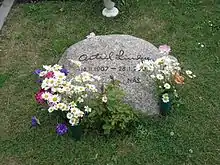
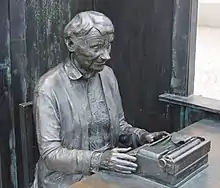
Lindgren's childhood home is near the statue and open to the public.[39] Just 100 metres (330 ft) from Astrid's Wellspring is a museum in her memory. The author is buried in Vimmerby where the Astrid Lindgren's World theme park is also located. The children's museum Junibacken, in Stockholm, was opened in June 1996 with the main theme of the permanent exhibition being devoted to Astrid Lindgren; at the heart of the museum is a theme train ride through the world of Astrid Lindgren's novels.
Works (selection)
Series
- Bill Bergson series (Mästerdetektiven Blomkvist)
- Bill Bergson, Master Detective (Mästerdetektiven Blomkvist, 1946)
- Bill Bergson Lives Dangerously (Mästerdetektiven Blomkvist lever farligt, 1951)
- Bill Bergson and the White Rose Rescue (Kalle Blomkvist och Rasmus, 1954)
- Children's Everywhere series
- Noriko-San: girl of Japan (also known as: Eva Visits Noriko-San, Swedish: Eva möter Noriko-san, 1956)
- Sia Lives on Kilimanjaro (Sia bor på Kilimandjaro, 1958)
- My Swedish Cousins (Mina svenska kusiner, 1959)
- Lilibet, circus child (Lilibet, cirkusbarn, 1960)
- Marko Lives in Yugoslavia (Marko bor i Jugoslavien, 1962)
- Dirk Lives in Holland (Jackie bor i Holland, 1963)
- Randi Lives in Norway (also known as: Gerda Lives in Norway, Swedish: Randi bor i Norge 1965)
- Noy Lives in Thailand (Noy bor i Thailand, 1966)
- Matti Lives in Finland (Matti bor i Finland, 1968)
- The Children on Troublemaker Street series
- The Children on Troublemaker Street (also known as: Lotta, Lotta Says No!, Mischievous Martens, Swedish: Barnen på Bråkmakargatan, 1956)
- Lotta on Troublemaker Street (also known as: Lotta Leaves Home, Lotta Makes a Mess, Swedish: Lotta på Bråkmakargatan, 1961)
- Lotta’s Bike (also known as: Of Course Polly Can Ride a Bike, Swedish: Visst kan Lotta cykla, 1971)
- Lotta’s Christmas Surprise (also known as: Of Course Polly Can Do Almost Anything, Swedish: Visst kan Lotta nästan allting, 1965
- Lotta’s Easter Surprise (Visst är Lotta en glad unge, 1990)
- Emil of Lönneberga series (Emil i Lönneberga)
- Emil in the Soup Tureen (also known as: Emil and the Great Escape, That Boy Emil!, Swedish: Emil i Lönneberga, 1963)
- Emil's Pranks (also known as: Emil and the Sneaky Rat, Emil Gets into Mischief, Swedish: Nya hyss av Emil i Lönneberga, 1966)
- Emil and Piggy Beast (also known as: Emil and His Clever Pig, Swedish: Än lever Emil i Lönneberga, 1970)
- Emil's Little Sister (also known as: När lilla Ida skulle göra hyss, 1984)
- Emil's Sticky Problem (also known as: Emils hyss nr 325, 1970)
- Karlsson-on-the-Roof series (Karlsson på taket)
- Karlsson-on-the-Roof (also known as: Karlson on the Roof, Swedish: Lillebror och Karlsson på taket, 1955)
- Karlson Flies Again (also known as: Karlsson-on-the-Roof is Sneaking Around Again, Swedish Karlsson på taket flyger igen, 1962)
- The World’s Best Karlson (Karlsson på taket smyger igen, 1968)
- Kati series
- Kati in America (Kati i Amerika, 1951)
- Kati in Italy (Kati på Kaptensgatan, 1952)
- Kati in Paris (Kati i Paris, 1953)
- Madicken series
- Mardie (also known as: Mischievous Meg, Swedish Madicken, 1960)
- Mardie to the Rescue (Madicken och Junibackens Pims, 1976)
- The Runaway Sleigh Ride (Titta, Madicken, det snöar!, 1983)
- Peter & Lena series
- I Want a Brother or Sister (also known as: That's My Baby, Swedish: Jag vill också ha ett syskon, 1971)
- I Want to Go to School Too (Jag vill också gå i skolan, 1971)
- Pippi Longstocking series (Pippi Långstrump)
- Pippi Longstocking (Pippi Långstrump, 1945)
- Pippi Goes On Board (also known as: Pippi Goes Aboard, Swedish: Pippi Långstrump går ombord, 1946)
- Pippi in the South Seas (Pippi Långstrump i Söderhavet, 1948)
- Pippi's After-Christmas Party (Pippi Långstrump har julgransplundring, 1950)
- Pippi Longstocking in the Park (Pippi Långstrump i Humlegården, 1945)
- Pippi Moves In! (Pippi flyttar in, 1969)
- The Six Bullerby Children / The Children of Noisy Village series (Barnen i Bullerbyn)
- The Children of Noisy Village (also known as: Cherry Time at Bullerby, Swedish: Alla vi barn i Bullerbyn , 1947)
- Happy Times in Noisy Village (Bara roligt i Bullerbyn, 1952)
- Christmas in Noisy Village (Jul i Bullerbyn, 1963)
- Springtime in Noisy Village (Vår i Bullerbyn', 1965)
- Children’s Day in Bullerbu (also known as: A Day at Bullerby, 1967)
- The Tomten series
- The Tomten (Tomte är vaken, 1960)
- The Tomten and the Fox (Räven och Tomten, 1966)
Individual books
- The Brothers Lionheart (Bröderna Lejonhjärta, 1973)
- Brenda Brave Helps Grandmother (Kajsa Kavat hjälper mormor, 1958)
- A Calf for Christmas (När Bäckhultarn for till stan, 1989)
- Christmas in the Stable (Jul i stallet, 1961)
- The Day Adam Got Mad (also known as: Goran’s Great Escape, The Day Adam Got Angry, Swedish: När Adam Engelbrekt blev tvärarg, 1991)
- The Dragon with Red Eyes (Draken med de röda ögonen, 1985)
- The Ghost of Skinny Jack (Skinn Skerping – Hemskast av alla spöken i Småland, 1986)
- How Astrid Lindgren achieved enactment of the 1988 law protecting farm animals in Sweden (Min ko vill ha roligt, 1990)
- I Don't Want to Go to Bed (Jag vill inte gå och lägga mig!, 1947)
- In the Land of Twilight (I Skymningslandet, 1994)
- Mio, My Son (also known as: Mio, My Mio, Swedish: Mio, min Mio, 1954)
- Mirabelle (Mirabell, 2002)
- Most Beloved Sister (also known as: My Very Own Sister, Swedish: Allrakäraste syster, 1973)
- My Nightingale Is Singing (Spelar min lind, sjunger min näktergal, 1959)
- Never Violence (Aldrig våld, 2018)
- Rasmus and the Vagabond (also known as: Rasmus and the Tramp, Swedish: Rasmus på luffen, 1956)
- Ronia the Robber's Daughter (Ronja rövardotter, 1981)
- The Red Bird (Sunnanäng, 1959)
- Scrap and the Pirates (also known as: Skrallan and the Pirates, Swedish: Skrållan och Sjörövarna, 1967)
- Simon Small Moves In (Nils Karlsson-Pyssling flyttar in, 1956)
- Samuel August from Sevedstorp and Hanna i Hult (also known as A love story, Swedish: Samuel August från Sevedstorp och Hanna i Hult, 1975)
- Seacrow Island (Vi på Saltkråkan, 1964)
- War Diaries, 1939-1945 (Krigsdagböcker 1939–1946, 2015)
Astrid Lindgren’s plays
In addition to her novels, short stories and picture books, Astrid Lindgren wrote some plays. Many of the plays were created in the 1940s and 1950s in collaboration with her friend Elsa Olenius, a pioneer in the Swedish children's theater. Many of the stories were written exclusively for the theater. They have been translated into several languages, including Danish, Finnish and Romanian. Most of Astrid Lindgren's plays have not been translated into English.
Filmography
This is a chronological list of feature films based on stories by Astrid Lindgren.[40][41] There are live action films as well as animated features. The most films were made in Sweden, followed by Russia. Some are international coproductions.
- Mästerdetektiven Blomkvist (1947) – director: Rolf Husberg
- Pippi Långstrump (1949) – director: Per Gunwall
- Mästerdetektiven och Rasmus (1953) – director: Rolf Husberg
- Luffaren och Rasmus (1955) – director: Rolf Husberg
- Rasmus, Pontus och Toker (1956) – director: Stig Olin
- Mästerdetektiven Blomkvist lever farligt (1957) – director: Olle Hellbom
- Alla vi barn i Bullerbyn (1960) – director: Olle Hellbom
- Bara roligt i Bullerbyn (1961) – director: Olle Hellbom
- Vi på Saltkråkan (1964 TV series, 1968 theatrical release) – director: Olle Hellbom
- Tjorven, Båtsman och Moses (1964) – director: Olle Hellbom
- Tjorven och Skrållan (1965) – director: Olle Hellbom
- Mästerdetektiven Blomkvist på nya äventyr (1966) – director: Etienne Glaser
- Tjorven och Mysak (1966) – director: Olle Hellbom
- Skrållan, Ruskprick och Knorrhane (1967) – director: Olle Hellbom
- Pippi Långstrump (1969, edited from 1968–69 TV series) – director: Olle Hellbom
- Här kommer Pippi Långstrump (1969, edited from 1968–69 TV series) – director: Olle Hellbom
- På rymmen med Pippi Långstrump (1970) – director: Olle Hellbom
- Pippi Långstrump på de sju haven (1970) – director: Olle Hellbom
- Emil i Lönneberga (1971) – director: Olle Hellbom
- Nya hyss av Emil i Lönneberga (1972) – director: Olle Hellbom
- Emil och griseknoen (1973), Emil and the Piglet – director: Olle Hellbom
- Världens bästa Karlsson (1974) – director: Olle Hellbom
- Priklyucheniya Kalle-syschika (1976) – director: Arūnas Žebriūnas
- Bröderna Lejonhjärta (1977) – director: Olle Hellbom
- Du är inte klok, Madicken (1979) – director: Göran Graffman
- Madicken på Junibacken (1980) – director: Göran Graffman
- Rasmus på luffen (1981) – director: Olle Hellbom
- Ronja Rövardotter (1984) – director: Tage Danielsson
- Emīla nedarbi (1985) – director: Varis Brasla
- The Children of Noisy Village (1986) – director: Lasse Hallström
- More About the Children of Noisy Village (1987) – director: Lasse Hallström
- Mio, min Mio (1987) – director: Vladimir Grammatikov
- Kajsa Kavat (1988) – director: Daniel Bergman
- The New Adventures of Pippi Longstocking (1988) – director: Ken Annakin
- Go'natt Herr Luffare (1988) – director: Daniel Bergman
- Allrakäraste syster (1988) – director: Göran Carmback
- Ingen rövare finns i skogen (1988) – director: Göran Carmback
- Gull-Pian (1988) – director: Staffan Götestam
- Hoppa högst (1988) – director: Johanna Hald
- Nånting levande åt Lame-Kal (1988) – director: Magnus Nanne
- Peter och Petra (1989) – director: Agneta Elers-Jarleman
- Nils Karlsson Pyssling (1990) – director: Staffan Götestam
- Pelle flyttar till Komfusenbo (1990) – director: Johanna Hald
- Lotta på Bråkmakargatan (1992) – director: Johanna Hald
- Lotta flyttar hemifrån (1993) – director: Johanna Hald
- Kalle Blomkvist – Mästerdetektiven lever farligt (1996) – director: Göran Carmback
- Kalle Blomkvist och Rasmus (1997) – director: Göran Carmback
- Pippi Longstocking (1997, animated) – director: Clive Smith
- Pippi Longstocking (1997 TV series) (1998, animated) – director: Paul Riley
- Karlsson på taket (2002, animated) – director: Vibeke Idsøe
- Tomte Tummetott and the Fox (2007, animated) – director: Sandra Schießl
- Emil & Ida i Lönneberga (2013) – director: Per Åhlin, Alicja Björk, Lasse Persson
- Sanzoku no Musume Rōnya (Ronja Rövardotter) Japanese TV series (2014–15) – director: Gorō Miyazaki
References
- Lentz Iii, Harris M. (9 April 2003). Obituaries in the Performing Arts, 2002: Film, television, Radio, Theatre, Dance, Music, Cartoons and Pop Culture. ISBN 9780786414642.
- "Astrid Lindgren Dies at 94". The Washington Post. 29 January 2002.
- "Astrid Lindgren: The Woman Behind Pippi Longstocking review". The Irish Times. Retrieved 3 May 2020.
- Andersen, Jens (27 February 2018). Astrid Lindgren: The Woman Behind Pippi Longstocking. Yale University Press. ISBN 978-0-300-23513-5.
- "UNESCO's statistics on whole Index Translationum database". UNESCO. Retrieved 22 February 2014.
- FAQ at Astrid Lindgren official site Archived 11 August 2010 at the Wayback Machine (in Swedish).
- Source – Steinar Mæland.
- Hagerfors, Anna-Maria (2002).
- "The Swedish secretary and journalist who sold 144 million books worldwide". Cineuropa - the best of european cinema. Retrieved 3 May 2020.
- Jørgensen, Jørn-Kr. "Harry Söderman". In Helle, Knut (ed.). Norsk biografisk leksikon (in Norwegian). Oslo: Kunnskapsforlaget. Retrieved 3 January 2013.
- "Astrid Lindgren". Lioness at Large. 6 June 2016. Retrieved 3 May 2020.
- "Astrid Lindgren". The Right Livelihood Award. Retrieved 3 May 2020.
- Fox, Margalit (29 January 2002). "Astrid Lindgren, Author of Children's Books, Dies at 94". The New York Times. ISSN 0362-4331. Retrieved 2 January 2019.
- Meri, Tiina. "PIPPI LONGSTOCKING – REBEL ROLE MODEL". sweden.se/. Sweden. Retrieved 16 January 2019.
-
"Deutscher Jugendliteraturpreis" Archived 29 July 2013 at the Wayback Machine. Arbeitskreis für Jugendliteratur e.V. (DJLP).
"German Children's Literature Award". English Key Facts. DJLP. Retrieved 2013-08-05. - Preisjahr "1956". Database search report. DJLP. Retrieved 5 August 2013. See "Kategorie: Prämie". The Happy Lion by Louise Fatio and Roger Duvoisin won the main Children's Book award (Kategorie: Kinderbuch).
- Personen "Lindgren, Astrid". Database search report. DJLP. Retrieved 5 August 2013.
- "Hans Christian Andersen Awards". International Board on Books for Young People (IBBY). Retrieved 5 August 2013.
-
"Astrid Lindgren" (pp. 24–25, by Eva Glistrup).
"Half a Century of the Hans Christian Andersen Awards" (pp. 14–21). Eva Glistrup.
The Hans Christian Andersen Awards, 1956–2002. IBBY. Gyldendal. 2002. Hosted by Austrian Literature Online. Retrieved 31 July 2013. - John-Henri, Holmberg (1997), "Scandinavia", in Clute, John; Grant, John (eds.), The Encyclopedia of Fantasy, New York: St. Martin's Griffin, p. 841
- John-Henri, Holmberg (1997), "Lindgren, Astrid (Anna Emilia)", in Clute, John, and John Grant (ed.), The Encyclopedia of Fantasy, New York: St. Martin's Griffin, p. 582
- Anette Øster Steffensen (2003): "Two Versions of the Same Narrative – Astrid Lindgren's Mio, min Mio in Swedish and Danish".
- "Astrid Lindgren timeline, 1974–76". Astrid-lindgren.com. Retrieved 22 February 2014.
- Stougaard-Nielsen, Jakob (2017). Scandinavian Crime Fiction. London: Bloomsbury Publishing. p. 77. ISBN 9781472522757.
- Biro, Jan (2009). The Swedish God. Los Angeles: Homulus Foundation. p. 55. ISBN 9780984210305.
- Andersen, Jens (2018). Astrid Lindgren: The Woman Behind Pippi Longstocking. New Haven: Yale University Press. ISBN 9780300226102.
- Clas Barkman (16 May 2010). "Brev från Astrid Lindgren visar hennes stöd för S". Dagens Nyheter. Archived from the original on 18 October 2012. Retrieved 22 February 2014.
- Christian Pfeiffer. "Außenansicht: Gewaltlosigkeit fängt bei den Kindern an".
- "Nachrichten für Kinder: Astrid Lindgrens Vision – niemals Gewalt!". kinder.wdr.de. 22 October 2018.
- "Lex Lindgren".
- "Was das Schwein Augusta gegen die Herren der Gewinnerzielung sagt".
- "Astrid Lindgren spoke, people listened". sweden.se. 4 June 2013.
- "Congratulations Katarina von Bredow!". Astrid Lindgren Memorial Award. 14 November 2013. Retrieved 3 May 2020.
- Lindgren, Astrid (14 April 2009). "ALMA - ALMA". www.alma.se. Retrieved 3 May 2020.
- "List of Registered Heritage: Astrid Lindgren Archives". UNESCO.
- "Sveriges Riksbank". The Riksbank. 30 September 2011. Archived from the original on 27 September 2011. Retrieved 22 February 2014.
- Dictionary of Minor Planet Names – p.256. Retrieved 22 February 2014.
- "Källa Astrid" på Astrids källa "Astrid's Wellspring [source of inspiration] in Astrid's Wellspring" Archived 28 August 2010 at the Wayback Machine. Kinda-Posten(in Swedish). Archived 12 November 2009 at the Wayback Machine
- "Vălkommen Till Astrid Lindgrens Năs". Astridlindgrensnas.se. Retrieved 22 February 2014.
- Films based on Astrid Lindgren stories (in Swedish).
- Astrid Lindgren at IMDb.
- Citations
- Hagerfors, Anna-Maria (2002), "Astrids sista farväl", Dagens nyheter, 8/3–2002.
Further reading
- Astrid Lindgren – en levnadsteckning. Margareta Strömstedt. Stockholm, Rabén & Sjögren, 1977.
- Paul Berf, Astrid Surmatz (ed.): Astrid Lindgren. Zum Donnerdrummel! Ein Werk-Porträt. Zweitausendeins, Frankfurt 2000 ISBN 3-8077-0160-5
- Vivi Edström: Astrid Lindgren. Im Land der Märchen und Abenteuer. Oetinger, Hamburg 1997 ISBN 3-7891-3402-3
- Maren Gottschalk: Jenseits von Bullerbü. Die Lebensgeschichte der Astrid Lindgren. Beltz & Gelberg, Weinheim 2006 ISBN 3-407-80970-0
- Jörg Knobloch (ed.): Praxis Lesen: Astrid Lindgren: A4-Arbeitsvorlagen Klasse 2–6, AOL-Verlag, Lichtenau 2002 ISBN 3-89111-653-5
- Sybil Gräfin Schönfeldt: Astrid Lindgren. 10. ed., Rowohlt, Reinbek 2000 ISBN 3-499-50371-9
- Margareta Strömstedt: Astrid Lindgren. Ein Lebensbild. Oetinger, Hamburg 2001 ISBN 3-7891-4717-6
- Astrid Surmatz: Pippi Långstrump als Paradigma. Die deutsche Rezeption Astrid Lindgrens und ihr internationaler Kontext. Francke, Tübingen, Basel 2005 ISBN 3-7720-3097-1
- Metcalf, Eva-Maria: Astrid Lindgren. New York, Twayne, 1995
- Astrid Anna Emilia Lindgren at Svenskt kvinnobiografiskt lexikon
External links
| Wikimedia Commons has media related to Astrid Lindgren. |
| Wikivoyage has a travel guide for Astrid Lindgren tourism. |
- AstridLindgren.se – official site produced by license holders
- Astrid Lindgren at IMDb
- Astrid Lindgren's World – official site of the theme park
- Astrid Lindgrens Näs – official site produced by the Astrid Lindgren-museum and culture center Astrid Lindgrens Näs in Vimmerby
- Astrid Lindgren – Right Livelihood Award (1994)
- Astrid Lindgren – fan site
- Petri Liukkonen. "Astrid Lindgren". Books and Writers
- Astrid spacecraft description at NASA Space Science Data Coordinated Archive
- Astrid Lindgren – profile at FamousAuthors.org
- Astrid Lindgren at Library of Congress Authorities, with 182 catalogue records